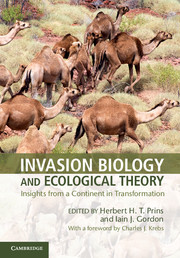1 - Testing hypotheses about biological invasions and Charles Darwin’s two-creators rumination
Published online by Cambridge University Press: 05 February 2014
Summary
Some of today’s most pressing issues deal with invasions by alien species into natural or man-made ecosystems such as agricultural landscapes. Invasions are not a new phenomenon having been a part of the relationship between man and the environment ever since humans moved out into the savannas; however, they became part of the ecological agenda in the middle of the last century. The foundations of invasion ecology stem from Charles Elton, who, in his book, The Ecology of Invasions by Animals and Plants (published in 1958) attempted to draw together three stands of ecology – faunal history, ecology, particularly population ecology, and conservation. Elton’s book had some traction at the time (e.g. Baker and Stebbins 1965), however, few ecologists paid much attention to invasions during the 1960s even though island biogeography theory (MacArthur and Wilson 1967) did provide theoretical frameworks for how new species fitted into the resident species communities on islands. It was not until the 1970s that invasion ecology began to gain traction in the literature (e.g. Baker 1974; Embree 1979) and continues to this day (Richardson 2011). There have been recent attempts to create unified theoretical frameworks for understanding the invasion process (Blackburn et al. 2011) and the traits that determine the degree to which a species can invade a new ecosystem or the degree to which an ecosystem can be invaded by a new species (Richardson and Pysek 2006). These developments provide a foundation upon which to assess the degree to which hypotheses concerning biological invasions relate to real-world case studies that are proliferating in the literature.
- Type
- Chapter
- Information
- Invasion Biology and Ecological TheoryInsights from a Continent in Transformation, pp. 1 - 20Publisher: Cambridge University PressPrint publication year: 2014
References
- 7
- Cited by

